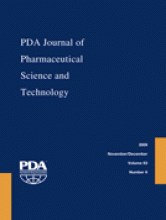Abstract
The traditional approach to virus filter spiking studies (virus added to the feed solution before the start of filtration) can lead to oversized viral filtration systems because of the non-representative volumetric throughputs (L/m2) that can be seen with the addition of the virus spike. The reduction in throughput is thought to be caused by interactions that take place between the species in the virus stock solution alone, or in conjunction with the species in the drug product. The traditional approach assumes that virus filter log reduction value (LRV) is directly related to volumetric throughput and limits manufacturing scale designs to the volumetric throughput achieved in the spiking study. This article references previous work that shows that % flow decay is a more relevant critical parameter than volumetric throughput for a poly(vinylidene diflouride) (PVDF) parvovirus filter. Based on this work, one could design the manufacturing-scale viral filtration system to the representative volumetric throughput achieved without the virus spike and implement a flow decay limit in manufacturing to ensure virus LRV. RUNspike is a complementary method that can be easily implemented today and that goes one step further. The RUNspike method challenges the same total virus as the traditional method, but the virus is added at the end of the filtration, after the representative volumetric throughput has been demonstrated. Comparable RUNspike and traditional LRV data, at the same flow decay, bridges the gap and strengthens the case for the flow decay-based design approach.
- Traditional virus spiking method
- Complementary RUNspike method
- PVDF parvovirus filter
- Spiking studies
- Virus stock solution contaminants
- Volumetric throughput (L/m2)
- Percent flow decay
- © PDA, Inc. 2009
PDA members receive access to all articles published in the current year and previous volume year. Institutional subscribers received access to all content. Log in below to receive access to this article if you are either of these.
If you are neither or you are a PDA member trying to access an article outside of your membership license, then you must purchase access to this article (below). If you do not have a username or password for JPST, you will be required to create an account prior to purchasing.
Full issue PDFs are for PDA members only.
Note to pda.org users
The PDA and PDA bookstore websites (www.pda.org and www.pda.org/bookstore) are separate websites from the PDA JPST website. When you first join PDA, your initial UserID and Password are sent to HighWirePress to create your PDA JPST account. Subsequent UserrID and Password changes required at the PDA websites will not pass on to PDA JPST and vice versa. If you forget your PDA JPST UserID and/or Password, you can request help to retrieve UserID and reset Password below.






